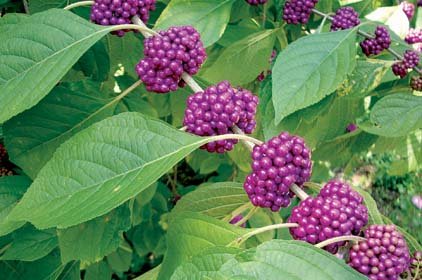LITTLE ROCK — Arkansans have always been conscientious about the environment, but today, sustainable gardening or "going green" seems to be of the utmost importance. When choosing plants for the landscape, many gardeners are looking for reliable performers that are showy, yet need minimal care. Easy-care plants should not be invasive - remember kudzu and English ivy.
One group of plants that seems to fit almost all of those criteria is native plants.
To help teach gardeners more about native plants, a Native Plant Workshop is being conducted at Garvan Woodland Gardens near Hot Springs on Oct. 8.
There are many definitions for native plants - native to Arkansas, native to the South, or simply native to the United States. As onegardener put it, all plants are native somewhere. To fit the criteria of low maintenance, able to adapt to local growing conditions and noninvasive, Arkansas gardeners should look a bit closer to home when choosing natives.
Plants that have been surviving on their own along roadsides and in wooded areas in the South should be well adapted to growing in our home landscapes. Native plants (also called indigenous plants) are those that have evolved and adapted to local conditions over thousands of years. They have adapted to the geography - including rocky soil or heavy clay, and climate of that region - whether hot and dry, or hot and humid.
Most regional natives are vigorous and hardy, so they can survive summer heat, winter cold, dry conditions or wet ones without additional care. When choosing native plants for your yard, match the conditions you have - sun or shade, wet or dry.
Each native plant species is a member of a community that includes other plants, animals and microorganisms. The natural balance in that community keeps each species in check, allowing the native plant to thrive in conditions where it is suited, but preventing it from taking over the garden.
Thus, native species rarely become invasive, as plants introduced from other areas can be (consider privet, kudzu, bamboo and vinca - all introduced and all highly invasive). A community of native plants provides habitat for a variety of native wildlife species such as birds and butterflies. Once established, they require little to no irrigation or fertilization, although they may really flourish with just a little extra care in your garden.
Native plants are resistantto most pests and diseases; there is no one to spray or monitor for pests in the wild, yet they still survive. And they suit today's interest in low-maintenance gardening and landscaping.
Native plants get no human support out in the wild, so even minimal care can go a long way for plant growth in your home landscape. Water is always a main consideration. Too much or too little can affect a plant's growth. Learning more about aquatics, or how to create a rain garden in those boggy spots, and knowing what plants will thrive with low maintenance is important.
One session at the workshop will cover using moss instead of a lawn as a ground cover and appreciating the beauty of lichens in the yard - and how to encourage more. Another session will help participants understand how to collect seeds from the wild, or from your landscape, and start new plants from them to increase your plant collections.
A common misconception about native plants is that they are weedy and only used in a meadow or naturalsetting. Actually, many great native perennials and shrubs are mainstays in gardens, including purple coneflower(Echinacea), Solomon's seal (Polygonatum multiflorum), black-eyed Susan (Rudbeckia hirta), blanket flower (Gaillardia), Mexican petunia (Ruellia) and various Gaura.
Native shrubs include yaupon holly (Ilex vomitoria), beautyberry (Callicarpa), sweet shrub or Carolina allspice (Calycanthus floridus), Florida anise (Illicium floridanum), native azaleas and summersweet (Clethra). Of course, many recognize the native trees, including oaks, hickories, pines and cedars, but don't forget such ornamental species as dogwoods, redbuds and magnolias.
"How native is your native?" will always be debated among plant folks. But most gardeners are interested in what works. Giving gardeners success without heavy maintenance schedules isimportant. Choosing plants that not only thrive, but don't spread prolifically is also important. Whether the plant is the native species or an improved cultivar of that native - called a nativar - really doesn't matter. What does is that we match the conditions in our yards with the conditions a plant needs to grow. So if you are looking for reliability and low maintenance, look no further than native plants; you have many options to choose from.
Plant workshop Oct. 8 at gardensThe Oct. 8 Native Plant Workshop at Garvan Woodland Gardens near Hot Springs is 9 a.m. to 3:30 p.m., and concludes with a plant sale from 3:30 to 6 p.m.
Finding unusual native plants can be difficult, so you will have the opportunity to buy some of those you learned about in the workshop - and fall is an ideal time to plant them.
Workshop topics include shady native annuals and perennials, shrubs and woodland plants, aquatic plants, lichens and moss, seed propagation, understory trees, designing a rain garden, edible natives, maintaining a native garden, and native bees. Participants will rank their top six choices and will be assigned to four sessions - first come, first served - with fifth and sixth topic choices assigned as other classes are filled. Cost for the workshop, including all program materials and lunch, is $45 for Garvan members and $60 for nonmembers. Space is limited, so call (501) 262-9300 or (800) 366-4664, or visit the Web site garvangardens.org to register.
Coming next week: Which home repairs
are vital and which can
be safely postponed or
done gradually to ease
strain on tightened
budgets? Find out more
next week.
HomeStyle, Pages 39, 44 on 09/26/2009

